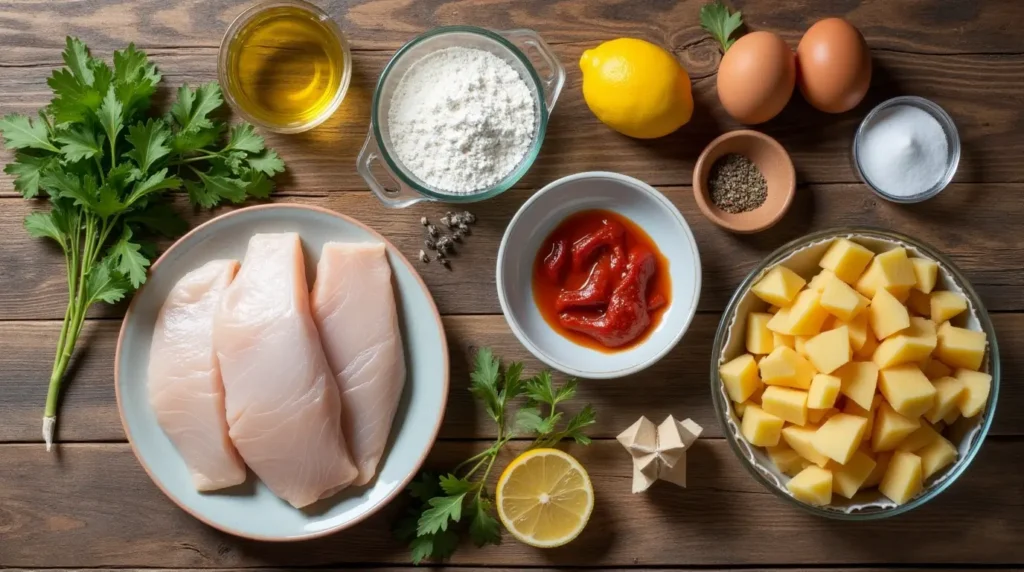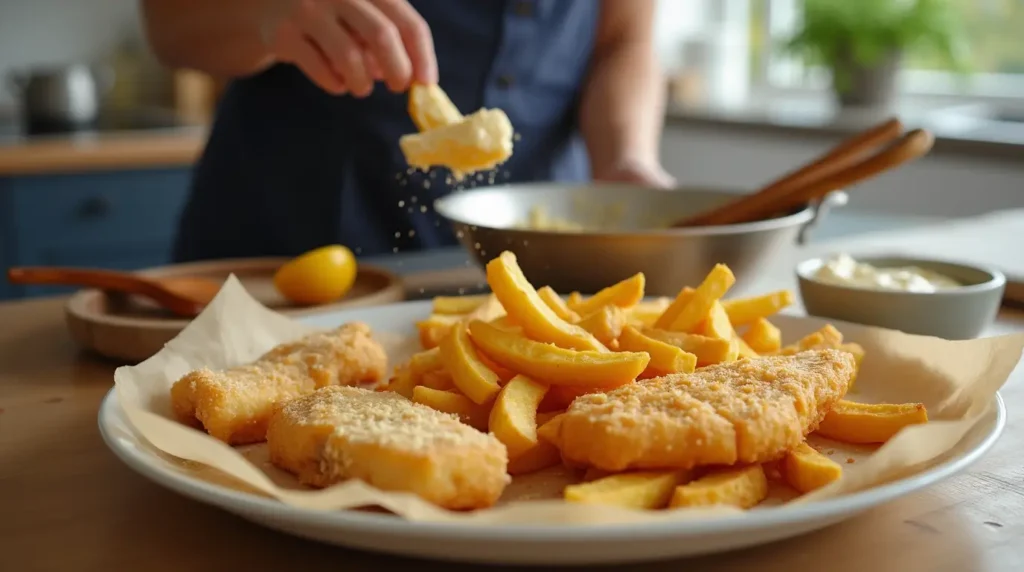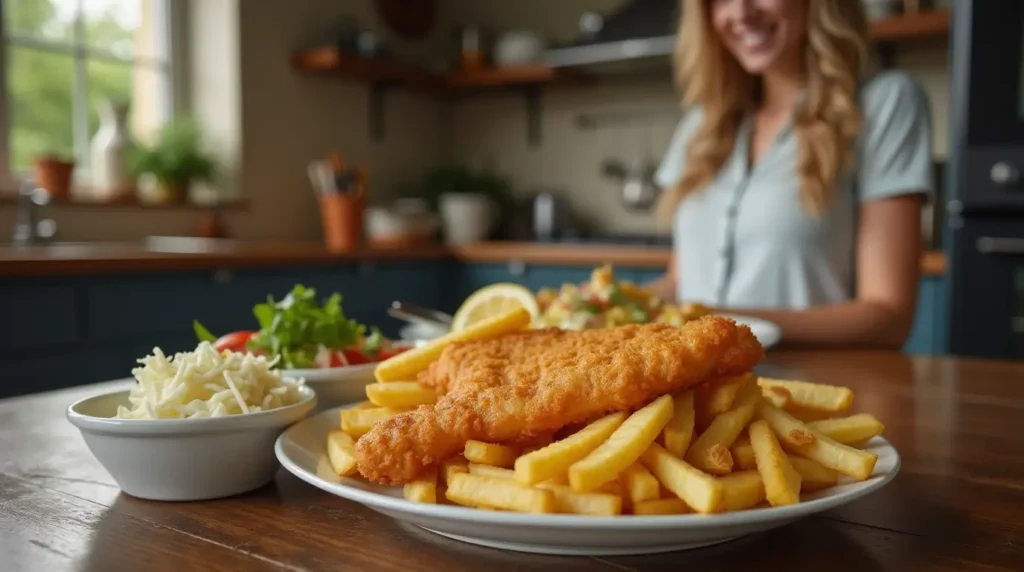Gluten Free Fish and Chips
Are you craving the classic comfort of fish and chips but need to avoid gluten? You’re not alone! This beloved British dish, with its crispy battered fish and perfectly fried potatoes, has been a favorite meal for centuries. But for those who need to eat gluten free, finding a version that matches the real thing can be challenging.
Today, I’m sharing my perfected gluten free fish and chips recipe that doesn’t compromise on taste or texture. You’ll achieve that wonderfully crisp coating and tender fish inside – all without a speck of gluten! Whether you’re cooking for someone with celiac disease or simply reducing gluten in your diet, this recipe delivers all the satisfaction of traditional fish and chips.
Why Go Gluten Free?
Understanding Gluten Restrictions
There are several reasons why you might be looking for gluten free fish and chips recipes:
- Celiac Disease: This autoimmune condition requires complete avoidance of gluten to prevent intestinal damage
- Gluten Sensitivity: Many people experience digestive discomfort or other symptoms when consuming gluten
- Dietary Preference: Some choose to limit gluten as part of a broader dietary approach
Whatever your reason, having access to delicious gluten free versions of favorite foods is important. Food should be enjoyable for everyone, regardless of dietary needs!
Benefits of Homemade Gluten Free Fish and Chips
Making your own gluten free fish and chips at home offers several advantages:
- Complete Control: You know exactly what ingredients are used
- Cross-Contamination Prevention: No risk of shared fryers or cooking surfaces
- Cost Savings: Restaurant gluten free options often come with a premium price
- Customization: Adjust seasonings and ingredients to your preference
- Freshness: Enjoy at peak crispiness, right from the fryer

Essential Ingredients for Gluten Free Fish and Chips
The key to amazing gluten free fish and chips lies in selecting the right ingredients. Here’s what you’ll need:
Best Fish Varieties
For authentic fish and chips, these fish varieties work best:
- Cod: Firm, flaky white flesh with mild flavor – the traditional choice
- Haddock: Slightly sweeter than cod, with firm texture
- Pollock: Budget-friendly option with similar qualities to cod
- Halibut: More premium option with delicate flavor
Choose thick fillets (about 1-inch thick) for best results with the batter.
Gluten Free Flour Alternatives
Your gluten free batter mix will need:
Batter Ingredients
| Ingredient | Amount | Purpose |
|---|---|---|
| Rice flour | 1 cup | Main flour base |
| Cornstarch | 1/2 cup | Creates crispiness |
| Potato starch | 1/4 cup | Helps with binding |
| Baking powder | 1 tbsp | Provides lightness |
| Salt | 1 tsp | Enhances flavor |
| Garlic powder | 1/2 tsp | Adds subtle flavor |
| Paprika | 1/4 tsp | Color and mild flavor |
Secret Ingredients for Extra Crispiness
These special additions make all the difference:
- Sparkling water: The carbonation creates air bubbles for a lighter batter
- Baking soda: A pinch helps achieve that golden crispiness
- Cornmeal: Adding a small amount provides extra crunch
- Cold temperature: Keeping the batter chilled improves results
Oil Recommendations
For the best frying results:
- Vegetable oil: Neutral flavor with high smoke point
- Canola oil: Another good neutral option
- Peanut oil: Excellent for high-heat frying (avoid if allergies are a concern)
- Sunflower oil: Clean flavor that works well for frying
Equipment You’ll Need
Temperature Control
- Deep-fry thermometer: Essential for maintaining the correct oil temperature (350-375°F)
- Instant-read thermometer: Helpful for checking fish doneness (internal temp of 145°F)
Cooking Vessels
- Deep fryer: Makes temperature control easier if you have one
- Dutch oven or heavy pot: At least 5-quart capacity for sufficient oil depth
- Cast iron skillet: Works for shallow frying if deep frying isn’t possible
Safety Tools
- Long tongs: Keep hands away from hot oil
- Spider strainer or slotted spoon: For safely removing food from oil
- Heat-resistant gloves: Extra protection when handling hot cookware
- Splatter screen: Reduces oil splashes

Step-by-Step Gluten Free Batter Technique
Perfect Batter Consistency
- Combine dry ingredients in a large bowl, whisking to remove any lumps
- Gradually add cold sparkling water, stirring gently until just combined
- Rest the batter in the refrigerator for 15-20 minutes
- Check consistency – it should coat the back of a spoon but still drip off slowly
The ideal batter shouldn’t be too thick (will become doughy) or too thin (won’t adhere properly).
Temperature Tricks for Maximum Crispiness
- Keep the batter cold until the moment you use it
- Pat fish completely dry before dipping in batter
- Dredge fish in a little rice flour before dipping in batter for better adhesion
- Let excess batter drip off before carefully placing in hot oil
Coating Techniques
For even coverage and optimal results:
- Dredge fish in seasoned rice flour
- Dip in gluten free batter, allowing excess to drip off
- Hold one end of the fish with tongs and lower the other end into the oil first
- Ease the rest in to prevent splashing and batter loss
Troubleshooting Common Batter Problems
- Batter falling off: Fish was too wet; ensure it’s completely dry before coating
- Soggy coating: Oil temperature too low; maintain between 350-375°F
- Batter too thick: Add a bit more sparkling water
- Batter too thin: Add a bit more rice flour mixture
The Ultimate Gluten Free Chips Recipe
Best Potatoes for Authentic Chips
- Russet potatoes: High starch content for fluffy interiors
- Yukon Gold: Slightly waxier but excellent flavor
- Maris Piper: Traditional British choice if you can find them
Pre-soaking and Drying Technique
- Peel potatoes and cut into 1/2-inch thick sticks
- Soak in cold water for at least 30 minutes (up to overnight)
- Rinse thoroughly to remove excess starch
- Dry completely on clean kitchen towels
This process removes excess starch and ensures crispy results.
Double-Frying Method
First Fry (Blanching):
- Heat oil to 325°F
- Fry potatoes in small batches for 4-5 minutes
- Remove when potatoes are soft but not browned
- Drain on paper towels and cool completely (can be refrigerated at this stage)
Second Fry (Crisping):
- Heat oil to 375°F
- Fry blanched potatoes until golden and crisp (2-3 minutes)
- Drain, salt immediately while hot
Seasoning Suggestions
- Classic: Sea salt only, sprinkled while hot
- Herb-seasoned: Salt mixed with dried parsley, garlic powder
- Spicy: Add paprika or cayenne to your salt
- Malt vinegar powder: For authentic flavor without gluten
Fish Frying Instructions
Oil Temperature Management
- Heat oil to 350-375°F before adding fish
- Use a thermometer to monitor temperature
- Allow oil to recover between batches
- Maintain temperature throughout cooking
Timing for Perfectly Cooked Fish
- Average cooking time: 4-6 minutes depending on thickness
- Turn once halfway through cooking
- Look for golden-brown color on the batter
- Check internal temperature: Should reach 145°F
Safety Tips While Frying
- Never leave hot oil unattended
- Keep a kitchen fire extinguisher nearby
- Don’t overcrowd the fryer (cook in batches)
- Pat excess moisture from fish to prevent dangerous splattering
- Lower food into oil slowly facing away from you
How to Know When Your Fish is Done
Your gluten free fish is done when:
- The batter is golden brown and crispy
- Fish flakes easily with a fork
- Internal temperature reaches 145°F
- It floats in the oil
Accompaniments and Serving Suggestions
Traditional Sides
Gluten Free Mushy Peas
- 2 cups frozen peas
- 2 tbsp butter or dairy-free alternative
- 1 tbsp fresh mint, chopped
- Salt and pepper to taste
Cook peas, drain, then mash with remaining ingredients to desired consistency.
Gluten Free Tartare Sauce
Ingredient List
| Ingredient | Amount |
|---|---|
| Mayonnaise | 1 cup |
| Dill pickles, finely chopped | 3 tbsp |
| Capers, rinsed and chopped | 1 tbsp |
| Fresh lemon juice | 1 tbsp |
| Fresh dill, chopped | 2 tsp |
| Salt and pepper | To taste |
Mix all ingredients and refrigerate for at least 30 minutes before serving.
Presentation Ideas
- Serve in paper cones lined with parchment for authentic presentation
- Use small metal fry baskets for a restaurant-style look
- Bundle in traditional newspaper-style parchment paper
- Serve on wooden boards with small ramekins for sauces
Lemon and Vinegar Options
- Fresh lemon wedges (essential!)
- Gluten free malt vinegar alternatives
- Apple cider vinegar with a touch of molasses
- White wine vinegar
Tips for Making Ahead and Storage
Keeping Leftovers Crispy
- Cool completely before storing
- Store fish and chips separately
- Use airtight containers but don’t seal completely (traps moisture)
- Place paper towels below and above fish to absorb moisture
Reheating Methods
- Oven method (preferred): 375°F for 10-15 minutes on a wire rack
- Air fryer: 3-4 minutes at 350°F
- Avoid microwave: Will make the coating soggy
Freezing Options
For the chips:
- Freeze after the first fry on a baking sheet
- Transfer to freezer bags once solid
- Finish with second fry directly from frozen (add 1-2 minutes to cooking time)
Fish is best made fresh, but can be frozen after cooking:
- Cool completely
- Wrap individually in parchment, then foil
- Reheat in 375°F oven until crisp and heated through
Variations on Gluten Free Fish and Chips
Air Fryer Adaptation
For a healthier version:
- Spray breaded fish with cooking oil spray
- Air fry at 390°F for 12-14 minutes, flipping halfway
- For chips, air fry at 380°F for 20 minutes, shaking halfway
Oven-Baked Option
- Preheat oven to 425°F with a baking sheet inside
- Coat fish in batter, then in gluten free panko crumbs
- Drizzle with oil and bake 15-20 minutes until golden
Different Coating Alternatives
- Gluten free panko crumbs: For extra crunch
- Crushed corn flakes: Creates golden crust
- Almond flour mixture: Lower carb option
- Chickpea batter: Different flavor profile
Fish Alternatives
- Shrimp: Smaller pieces cook quickly
- Chicken tenders: For a fish and “chicks” variation
- Firm tofu: Plant-based option
- Vegetables: Cauliflower, zucchini, or onion rings

Frequently Asked Questions
What makes gluten free fish and chips different from regular fish and chips?
Gluten free fish and chips uses alternative flours like rice flour, cornstarch, and potato starch instead of wheat flour for the batter. The cooking technique remains similar, but the ingredient selection ensures there’s no gluten present, making it safe for those with celiac disease or gluten sensitivity.
Can I make gluten free fish and chips without a deep fryer?
Absolutely! While a deep fryer makes temperature control easier, a heavy pot like a Dutch oven works perfectly. Use a thermometer to maintain proper oil temperature. For a healthier version, you can also make gluten free fish and chips in an air fryer or oven.
Why is my gluten free batter falling off the fish?
This usually happens when the fish is too wet or the batter is too thin. Make sure to thoroughly pat the fish dry before coating, and try dredging it in a little rice flour before dipping in batter. Also, check that your oil is hot enough (350-375°F) before adding the fish.
What’s the best way to keep gluten free fish and chips crispy?
For maximum crispiness, serve immediately after cooking. If you need to keep them warm, place on a wire rack in a low oven (200°F). Never cover hot fried food with foil or place in a closed container while hot, as this traps steam and creates sogginess.
Conclusion
Creating delicious gluten free fish and chips at home is absolutely possible with the right ingredients and techniques. This recipe gives you all the satisfaction of the traditional dish – that perfect contrast between crispy coating and tender fish, accompanied by golden, fluffy chips – without any gluten concerns.
Don’t be intimidated by the frying process! With practice, you’ll master the art of gluten free battering and frying, opening up a world of possibilities for other fried favorites you might have been missing.
Why not plan a fish and chips night this weekend? Gather your ingredients, prepare your stations, and enjoy the process of creating this classic comfort food. Your family and friends will be impressed by your homemade gluten free fish and chips – they might not even realize it’s gluten free!
Have you tried making gluten free fish and chips before? Share your experience in the comments below, and don’t forget to save this recipe for your next comfort food craving!

